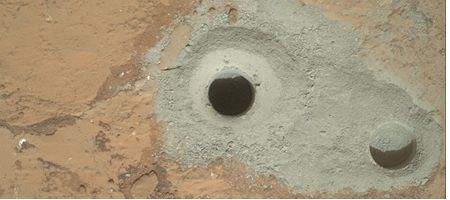NASA’s Curiosity rover has, for the first time, used the drill on its robotic arm to bore into a rock on Mars and extract a sample for analysis.

It’s drilled the hole, about 0.63 inch wide and 2.5 inches deep, in a patch of fine-grained sedimentary bedrock. The next step is an on-board analysis that could reveal evidence about the presence of water in the past.
“The most advanced planetary robot ever designed now is a fully operating analytical laboratory on Mars,” says John Grunsfeld, NASA associate administrator for the agency’s Science Mission Directorate. “This is the biggest milestone accomplishment for the Curiosity team since the sky-crane landing last August, another proud day for America.”
Over the next few days, ground controllers will command the rover’s arm to carry out the steps involved in processing the sample.
“We commanded the first full-depth drilling, and we believe we have collected sufficient material from the rock to meet our objectives of hardware cleaning and sample drop-off,” says Avi Okon, drill cognizant engineer at NASA’s Jet Propulsion Laboratory (JPL) in Pasadena.
The rock powder created during drilling travels up flutes on the bit to chambers at the top. Next, it’ll be transferred to the sample-handling mechanisms of the rover’s Collection and Handling for In-Situ Martian Rock Analysis (CHIMRA) device.
Some of the dust will first be used to scour away any remaining traces of material from Earth.
“We’ll take the powder we acquired and swish it around to scrub the internal surfaces of the drill bit assembly,” says JPL’s Scott McCloskey, drill systems engineer. “Then we’ll use the arm to transfer the powder out of the drill into the scoop, which will be our first chance to see the acquired sample.”
Inside the sample-handling device, the powder will be vibrated once or twice over a sieve that screens out any particles larger than 150 microns across. Small portions of what’s left will fall through ports on the rover deck into the Chemistry and Mineralogy (CheMin) instrument and the Sample Analysis at Mars (SAM) instrument – which will then begin their detailed analysis.






